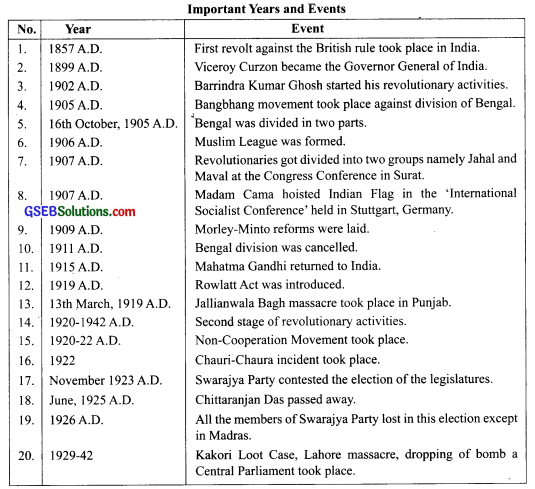Our Revision Notes for GSEB Class 9 Social Science Notes Chapter 4 National Movements of India summarises the key points of a chapter and useful resource to prepare effectively for the upcoming board exams.
National Movements of India Class 9 GSEB Notes Social Science Chapter 4
National Movements of India Class 9 GSEB Notes
→ During the 100 years of rule the English residing in India established such a law and administration that they made England prosperous and exploited India the most.
→ Reasons of the Great National uprising of 1857: Some of the factors that caused the uprising of 1857 were political dissatisfaction, economic exploitation, social and religious factors, military factor and immediate reasons like induction of the Enfield Rifle in the army.
![]()
→ Mangal Pandey was the first martyr of the uprising. The reasons responsible for the failure of the 1857 uprising are the beginning of the uprising before the planned time, lack of central leadership, insufficient and unsophisticated weapons, importance of self-centered interests than nationalism amongst revolutionaries, lack of suitable and organized leadership etc.
→ Boycott and Indigenuous Movements:- Viceroy Curzon divided the vast Bengal Province into East Bengal and West Bengal, in the name of bringing about administrative efficiency.
→ The real reason was the divide the Hindus and the Muslims.
→ Partition of Bengal was enforced on 16th October, 1905. The day of participation was observed as the day of national mourning.
The movement has three major characteristics:
- Adoption of indigenous goods
- Boycott of foreign goods
- Adoption of national education
→ It was believed that the boycott of the foreign goods will benefit Indian Industries.
→ The huge economic loss caused by the boycott forced the British Parliament to reconsider the decision on partitions in 1911.
→ Thus was the noteworthy victory of the new awakening against the English rule.
![]()
→ The Religious head of the Muslim Agakhan Nawab of Dhaka Salimulla Khan Governor General Lord MInto encouraged the establishment of the All India Muslim League in 1906.
→ Many writers considered split in Hindu-Muslim unity in 1906 led to the eventual partition of India in 1947.A
→ Birth and Development of Revolutional movements
→ Revolutionary activity in India was started by Vasudev Balwant Phadke. The other revolutionaries were Damodar Chaphekar and Balkrishna Chaphekar brothers, Vir Savarkar, Baarindranath Ghosh, Khudiram Bose, Praful Chaki, Ramprasad ‘Bismil’, Asfaqullakhan, Chandrashekhar Azad Bhagatsingh, Shivram Raj guru, Sukhdev, Batukeshwar Dutt, Roshansingh etc.
→ The Indian National Congress was divided into two groups Jahal and Maval at the Congress Conference in Surat and the terrific opposition to practice of Congress of making only resoulutions and requests.
→ Lal-Bal-Pal trio adopted the radical attitude which brought new life in the young Indian activists.
→ Tilak had declared that “Freedom is my birthright and I shal have it.”. This became the maxim for the freedom fighters.
![]()
→ Revolutionaiy activities spread in Maharashtra, Bengal, Punjab, Bihar, Orissa, Gujarat, Rajasthan, Madras province, Uttarpradesh and Central India.
→ In the first stage newspapers and magazines like ‘Yugantar’, ‘Navshakti’ and ‘Vandematram’, ‘Kesari’, ‘Maratha’ gave constant strength to the activites.
→ In the second stage events like ‘Kakori Loot case’, ‘Lahore massacre’ and dropping of bomb on Central Parliament took place.
→ Sri Aurobindo Ghosh was the pioneer of armed revolution in Gujarat. But he remained behind the curtain. His brother Baarindrakumar Ghosh always remained in the forefromt.
→ He arrived in Gujarat and moved towards the southern part.
→ Shri Chotubhai and Shri Ambubhai Purani, Shakaria Swami were his companions.
→ The revolutionary movement spread outside India. Many out side Indians formed organization to support revolutionary activities and express resentment against the British rule in India.
→ The English adopted the policy of ‘Divide and Rule’ to create enmity between Hindus and Muslims. Under the leadership of Agakhan, Muslim delegation met Viceroy Minto. Morley was the Indian Vizier at that time. These reforms are known as Morley-Minto reforms.
![]()
→ After successfully fighting against racism in South Africa Gandhiji returned to India.
→ Gandhiji travelled across India and observed the life of Indians. He considered exploitation as the root of poverty in India and made plans to abolish British rule in India.
→ The Rowlatt act was framed with the purpose of suppressing revolutionaries and nationalists.
→ This act came to be known as ‘Black Act’ because it was meant to suppress individual freedom and freedom of speech.
→ In the public meeting at Jallianwala Bagh in Amritsar General Dyer reached with his troops and without any warning, opened fire on innocent people from the machine gun.
→ Number of people lost their lives in firing. After this inhuman act, Gandhiji lost his faith towards British.
→ The sultan of Turkey had entered the first world war on the side of Germany. Turkey was defeated in the war and many unjust conditions were imposed. The Sultan was the head of the Muslims. Movement in India, to oppose the strict terms imposed on Turky and the Sultan, started. This came to be known as Khilafat movement.
→ Gandiji launched the Non-Cooperation movement in 1920. It comprised of some negative and some constructive programmes. During this movement a violent incident took place at Chauri- Chaura in 1922. In which 21 policemen were burnt alive. Thus Gandhiji suspended the non¬cooperation movement.
![]()
→ With the purpose of retaining the national awareness among people, Chittaranjan Das and Motilal Nehru formed the Swarajya Party.
→ This party contested elections to central and Provincial legislatures in 1923.
→ It secured majority of seats in some provinces.
→ It performed remarkable work. However after the death of Chittranjan Das party became weak.
